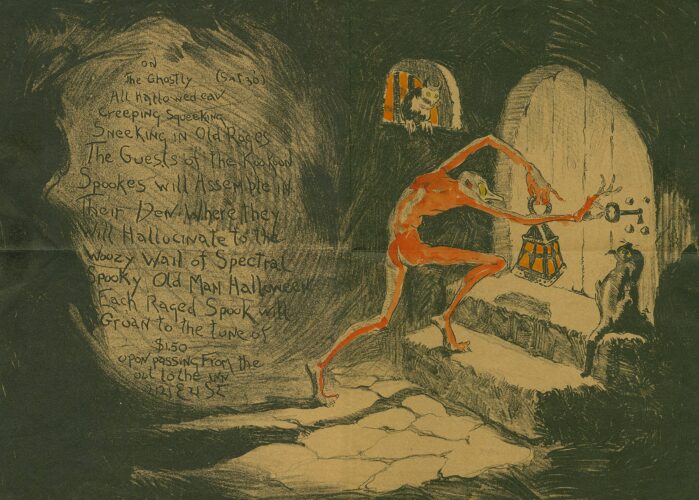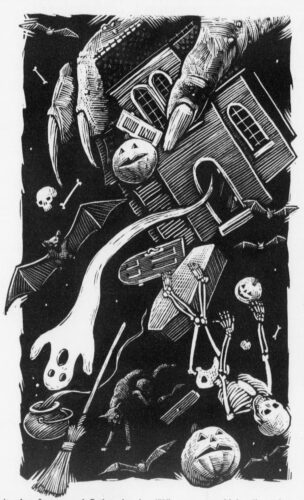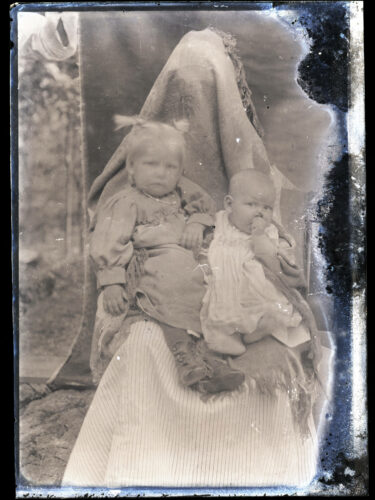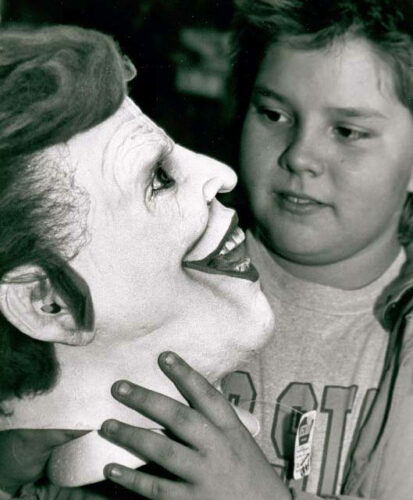Happy Halloween from Ohio Memory!

Calling all goblins, ghouls, witches, and werewolves– it’s spooky season! Whether you live for the bone-chilling fear of ambling through a haunted house, the cheesy gore of your favorite slasher film, or simply love the chance to assemble an out of this world costume to greet trick-or-treaters, Halloween has something for everyone. Ohio Memory has something for everyone, too! Browse Ohio Memory for historic images of Halloween parties and costumes, some of Ohio’s supposedly haunted buildings like the Columbian House or the Cincinnati Music Hall, and a 19th century illustrated edition of Edgar Allen Poe’s The Raven (read more about this rare book in another blog post).
The Kokoon Arts Club poster shown above pairs a frightening illustration with an equally

frightening invitation to a Halloween party. In this eerie work, a bony Old Man Halloween is accompanied by an owl and black cat, both timeless horror tropes. The Kokoon Arts Club was founded in 1912 by a group of young artists in an abandoned tailor shop on East 36th Street in Cleveland. Inspired by the international Dadaist movement in the same spirit as similar avant-garde organizations, the club’s name derives from “the lowly cocoon…forerunner of the beautiful butterfly [in] hope that from this small beginning something of beauty should develop and emerge.”
This fun illustration (right) accompanies an article in a 1994 issue of the Amherst News-Times titled “Bewitching life,” that introduces readers to a real witch in the neighborhood. Referred to here as Rain, a local Amherst resident describes her lifestyle and beliefs as a practicing pagan. She makes the distinction between the stereotypical and ignorant portrayal of witches as Satan’s wives, and the true beliefs of pagans, which are based in nature and using earth’s gifts. In her interview, Rain provides a history of witches, which she states long predates the most commonly known history of the witch hunts of 17th century New England.

Although there is nothing inherently “Halloween” about these portraits, there is something unsettling about the “hidden mother” phenomenon. This technique was commonly used in the 19th century to photograph young children. The children’s mother would sit in a chair with a blanket or shawl covering her head, torso, and arms, so that she was unseen but could still safely and securely hold her children long enough for a photograph. Early cameras used during this time period had long exposure times, which forced subjects to sit still for an extended period of time for the capture to complete, sometimes as long as several minutes. Sometimes, the posture and pose of the mother and children truly do hide the person under the blanket. While other times, the contours and folds of the garment clearly outline the hidden figure beneath, like the photograph shown here (left).
You can also find some not-so-spooky Halloween materials on Ohio Memory, like this child staring into the eyes of Joker, Batman’s mortal enemy, at a costume shop in Toledo, Ohio, in the 1990s. On a day when you can transform into anyone, or any thing, the world is your oyster!

Thank you to Kristen Newby, Digital Projects Coordinator at the Ohio History Connection, for this week’s post!



Leave a Reply
You must be logged in to post a comment.